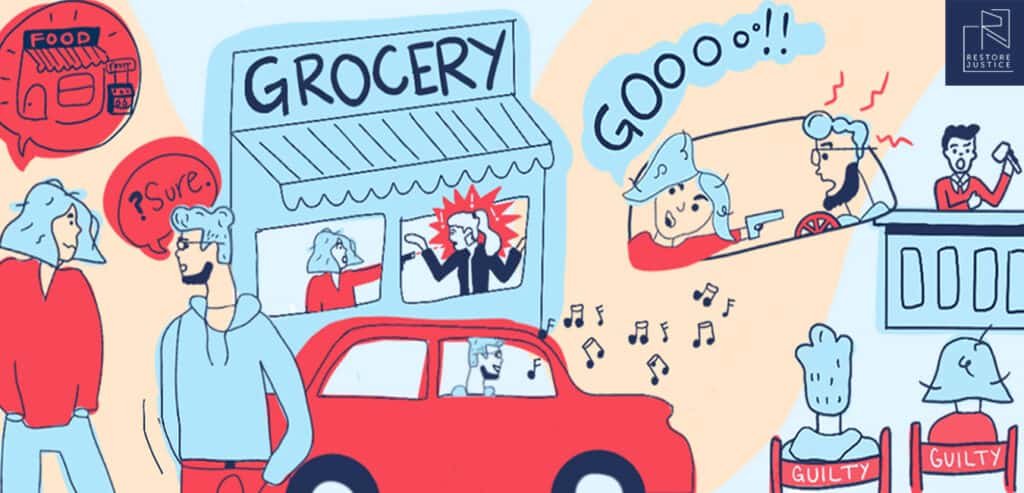WHAT IS ILLINOIS’ “LAW OF ACCOUNTABILITY”?
In Illinois, it is legal for a person to be arrested, charged, and convicted of a crime they not only did not commit but also did not plan, agree, or intend to commit, and at which they were not even present. Like many states, Illinois has enacted a statute generally known as an “accomplice liability law,” which allows a person to be held criminally responsible for someone else’s actions. In Illinois, this statute is called the “law of accountability,” or “accountability theory.”
The law of accountability is a legal mechanism the state uses to convict people of crimes with which they were associated but did not commit. Accountability is not the definition of a criminal offense, but rather is applied to people who were “accessories” or “passive participants” in a crime.
Specifically, the law of accountability states that a person is legally responsible for another person’s illegal conduct if “either before or during the commission of an offense, and with the intent to promote or facilitate that commission, he or she solicits, aids, abets, agrees, or attempts to aid that other person in the planning or commission of the offense” (720 ILCS 5/5-2). In cases where the law of accountability has been challenged, Illinois Courts have held that to prove a defendant possessed the intent to promote or facilitate the crime, evidence may be presented that (1) the defendant shared the criminal intent of the person who actually committed the crime, or (2) there was a common “criminal design” or plan. The second holding has become known as the “common-design rule.”
Under the common-design rule, if two or more people engage in or agree to engage in a criminal act together, any additional criminal acts committed by one person are considered to be the acts of all persons. Everyone is held equally responsible for the consequences of further acts. Under this rule, evidence that a person attached themselves to a group of people intent on committing one crime can be used to sustain his or her conviction for any other offense committed by a member of the group. This means that if someone assists in any way in the planning or commission of a crime, or exhibits more than “mere presence” at the scene of the crime, that person can be charged, convicted, and sentenced as if they actually committed the crime.
The court uses six factors to determine if a person is accountable for the unlawful acts of another person. These factors are: (1) being present during the commission of the crime (unless the person attempted to leave or prevent the crime), (2) acting as a lookout, (3) fleeing the scene after the crime, (4) continuing to associate with the principle actor after the criminal act, (5) failing to report the incident, and (6) accepting illegal proceeds of the crime.
The law of accountability allows a person to be convicted for crimes committed by another person, even if the other person has not been charged or has been acquitted or found guilty only of a lesser offense (720 ILCS 5/5-3).
WHY DOES IT MATTER?
The law of accountability is a tool that is especially useful to law enforcement in cases that involve what they perceive to be criminal organizations or gangs. Because accountability can be used to threaten lesser participants with long criminal sentences, law enforcement can, in many cases, leverage information and plea deals that they could not otherwise secure.
Typically, to be found guilty of any crime there must be evidence of a criminal act (actus reus) and a criminal mindset (mens rea). The law of accountability bypasses this two-part legal requirement by relying on something called “the natural and probable cause doctrine” (Heyman, 2010). Under this doctrine, a person can be held legally responsible for all of the illegal conduct of another person if the “subsequent crime was a foreseeable consequence of the first, no matter how indistinct.”
The law of accountability is pernicious because it can be applied to any other criminal offense. This means that a person can be held accountable for any crime—felony or misdemeanor—committed by another person if a relatively low standard of evidence, under the natural and probable cause doctrine, is met. Moreover, the common-design rule makes a person legally responsible not only for the crime they helped to plan or commit but also for all other offenses committed by a co-offender during the commission of the planned offense, even if the crime was not a part of the original plan.
Under the common-design rule, “the only necessary element to support a conviction” is the decision to engage in the initial crime. Consequently, the common-design rule ignores the degree of participation and the intent of the person charged with the crime, and, instead, holds them liable for every criminal act committed. Because of this, the law of accountability blurs the lines between so-called “violent” and “non-violent” offenders. Because the law of accountability is designed to catch passive participants and those with peripheral roles in a crime, the people convicted under this rule usually did not personally cause harm or violence. As a result, there are likely hundreds of people who have been convicted of and are currently serving life, de facto life, and other long-term sentences for so-called “violent crimes,” including murder, but who have not personally committed any acts of violence.
Because, our criminal legal data systems do not differentiate between who was convicted for actually committing an offense and who was convicted under the theory of accountability, the exact number of those affected is unknown. We have no way to know how many of the more than 6,500 people currently in Illinois Department of Corrections custody or under state supervision who were convicted of murder were actually charged under the theory of accountability.
YOUTH AND THE LAW OF ACCOUNTABILITY
Youthful offenders are more likely to act in groups (or “co-offend”) and are more susceptible to peer pressure. They are, thus, disproportionately affected by the law of accountability. The US Supreme Court established that children lack maturity and have an underdeveloped sense of responsibility that makes them more reckless, impulsive, and risk-prone than adults, and that they are also more susceptible to rehabilitation. But, when convicted under a theory of accountability, children are often branded “violent offenders” for life and are subject to the same sentencing range as the person who actually committed the violent act. This is true even if they did not inflict any harm or commit any acts of violence. Young people convicted of murder under the law of accountability usually receive life, de-facto life, or other extreme sentences.
Possible Scenarios that Could Lead to a Conviction Under a Theory of Accountability:

- Jack, a minor, and Jill, legally an adult, agree to rob a grocery store. Jack waits in the getaway car while Jill goes into the store and robs it at gunpoint. During the course of this robbery, Jill intentionally shoots and kills the store clerk. Jack could be charged with armed robbery and first-degree murder, under a theory of accountability, even though the death of the store clerk was not a part of the original plan and Jack was waiting in the car.
- Jack and Jill agree to rob a grocery store. Jack waits in the getaway car while Jill goes into the store and robs it at gunpoint. During the course of this robbery, Jill unintentionally shoots and kills the store clerk. Jack could be charged with armed robbery and first-degree murder, under a theory of accountability, even though the death of the store clerk was unintentional, not a part of the original plan, and Jack was waiting in the car.
- Jack agrees to give Jill a ride to the grocery store. Unbeknownst to Jack, Jill robs the store at gunpoint. While waiting in the car, Jack hears a gunshot, and, shortly thereafter, Jill returns to the car. Jack asks, “What happened?” and Jill replies, “I robbed the place. Drive!” Jack sees someone run toward his car shouting, “Stop, thief,” and Jack drives away not knowing that Jill shot and killed a store clerk. Jack could be charged with armed robbery and first-degree murder, under a theory of accountability, because he fled the scene, continued to associate with Jill, and failed to report the crime to the police. This would be true even though Jack did not know Jill intended to rob the store, that Jill was armed, or that Jill shot and killed the store clerk.
In these three scenarios, Jack could be charged with one or more crimes under the law of accountability, even though he (1) did not possess or fire a weapon, (2) may not have known that Jill possessed a weapon, (3) was not present, (4) did not know a crime would occur, and/or (5) was a juvenile while Jill was an adult. Jack could be charged and sentenced as if he himself committed these crimes.
HISTORY AND POLITICS
The theory of accountability has a long history in criminal law. It originated from the common law, or “the body of law derived from judicial decisions.” The Model Penal Code (“Penal Code”) sought to limit the law of accountability, especially as it related to the common-design rule. The Penal Code established very basic requirements for imposing criminal liability for another person’s crime. Specifically, the Penal Code “required the purposeful promotion or facilitation” of the planned offense (Heyman, 2014).
In 1954, the Illinois Bar Association and Chicago Bar Association established a joint committee to update the Illinois Criminal Code. The committee completed its work in 1960, and the governor and General Assembly then approved the changes. The new draft, known as the Criminal Code of 1961, took effect on January 1, 1962.
The Criminal Code of 1961 (“Criminal Code”), like the Penal Code, removed references to the common law, including the common-design rule (Decker and Kopacz). In fact, the accountability section of the Criminal Code is taken virtually verbatim from the Penal Code, which requires an individual to intentionally assist another person in the commission of a crime in order for that individual to be held criminally liable. As such, it sought to eliminate the common-design rule.
Nevertheless, since the enactment of the Criminal Code of 1961, judicial opinions resurrected and incorporated the common-design rule into Illinois accountability law (Heyman, 2014). “Entirely ignoring both the statutory language and legislative history, the [Illinois Supreme Court] proclaimed the accountability statute as embodying the ‘intent’ of incorporating ‘the principle of the common-design rule” (Heyman, 2013). By doing so, “the Illinois Courts have resurrected a common law rule of accountability for which there is no statutory authority” (Heyman, 2013).
However, in 2008, the Illinois General Assembly made the common-design rule a part of the accountability statute by adding the following paragraph:
“When 2 or more persons engage in a common criminal design or agreement, any acts in the furtherance of that common design committed by one party are considered to be the acts of all parties to the common design or agreement and all are equally responsible for the consequences of those further acts. Mere presence at the scene of a crime does not render a person accountable for an offense; a person’s presence at the scene of a crime, however, may be considered with other circumstances by the trier of fact when determining accountability” (720 ILCS 5/5-2).
By codifying the common-design rule, the Illinois General Assembly solidified “an incredibly expansive mechanism for convicting offenders of criminal acts in which they did not partake and never intended to partake,” Brooke Troutman writes. This is contrary to the intent of the drafters of the Model Penal Code, the Illinois Criminal Code of 1961, and the recommendations of the Illinois Criminal Code Reform and Rewrite Commission, which also recommended “the elimination of the common-design rule for complicity liability.”
WANT TO LEARN MORE?
The following resources will provide you with more information about the theory of accountability:
Brooke Troutman, A More Just System of Juvenile Justice: Creating a New Standard of Accountability for Juveniles in Illinois, 108 J. Crim. L. & Criminology 197 (2018). Retrieved from: https://scholarlycommons.law.northwestern.edu/cgi/viewcontent.cgi?article=7621&context=jclc
Michael G. Heyman, The Natural and Probable Consequences Doctrine: A Case Study in Failed Law Reform, 15 Berkeley J. Crim. L.388(2010). Retrieved from: https://repository.jmls.edu/cgi/viewcontent.cgi?article=1047&context=facpubs
Michael Heyman, Losing All Sense of Just Proportion: The Peculiar Law of Accomplice Liability, 87 St. John’s Law Rev. 129 (2013). Retrieved from: https://repository.jmls.edu/cgi/viewcontent.cgi?article=1454&context=facpubs
Michael G, Heyman, Clinging to the Common Law in an Age of Statutes: Criminal Law in the States, 99 Minnesota L. Rev. 29, 31 (2014). Retrieved from: http://www.minnesotalawreview.org/wp-content/uploads/2014/12/Heyman_2fmt.pdf
Sabo, Victoria, “Social Relationships in Young Offenders: Relevance to Peers, Poverty, and Psychological Adjustment” (2017). Electronic Thesis and Dissertation Repository. 4364. Retrieved from: https://ir.lib.uwo.ca/cgi/viewcontent.cgi?article=6097&context=etd
ALL WORKS CITED
720 ILCS 5/5-2 (When accountability exists).
720 ILCS 5/5-3 (Separate conviction of person accountable).
Black’s Law Dictionary, 279 (7th ed. 1999)
Brooke Troutman, A More Just System of Juvenile Justice: Creating a New Standard of Accountability for Juvenile in Illinois, The Journal of Criminal Law & Criminology, 108 J. Crim. L. & Criminology 197, 215 (2018).
“Co-Offending with Peers. Co-offending has recently become a burgeoning topic in the youth offending literature. High prevalence of peer interaction in adolescence may present more opportunities for co-offending. Indeed, youth are more likely to co-offend in comparison to their adult counterparts, and with a higher number of offenders involved (Weerman, 2003).” https://ir.lib.uwo.ca/cgi/viewcontent.cgi?article=6097&context=etd
Final Report of the Illinois Criminal Code Reform and Rewrite Commission, Public Law and Legal Theory Research Paper Series Research Paper No. 09-40 (2003).
Illinois Criminal Law: A Survey of Crimes and Defenses, 3:03
Michael G. Heyman, The Natural and Probable Consequences Doctrine: A Case Study in Failed Law Reform, 15 Berkeley J. Crim. L. 388, 395 (2010).
Michael G. Heyman, Losing All Sense of Just Proportion: The Peculiar Law of Accomplice Liability, 87 St. John’s Law Rev. 129, 155, note 122 (2013).
Michael G, Heyman, Clinging to the Common Law in an Age of Statutes: Criminal Law in the States, 99 Minnesota L. Rev. 29, 31 (2014).
Model Penal Code Pt. I: General Provisions (Official Draft and Revised Comments 1985), Pt II: Definition of Specific Crimes (Official Draft and Revised Comments 1980).

